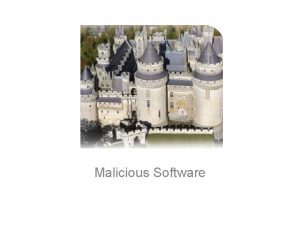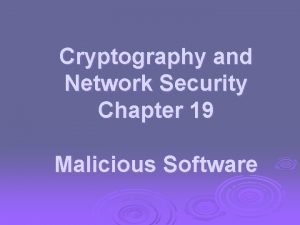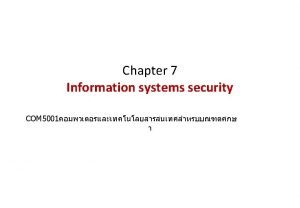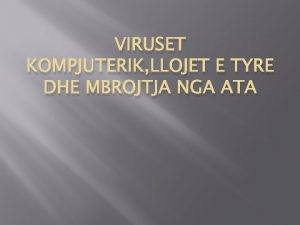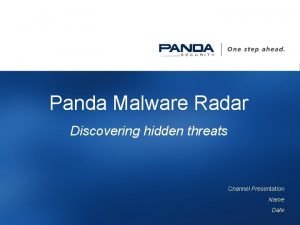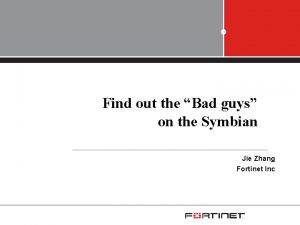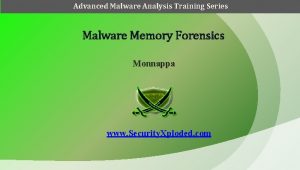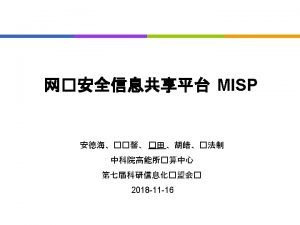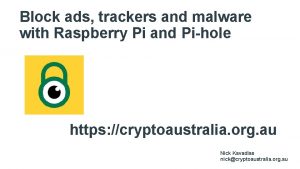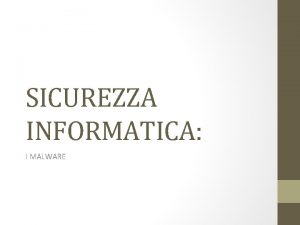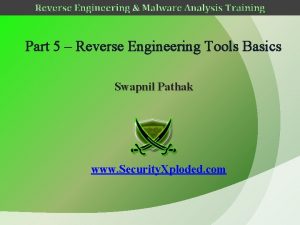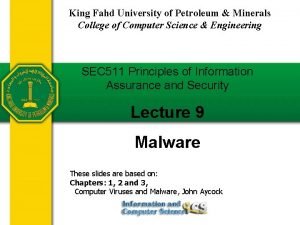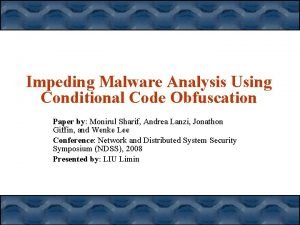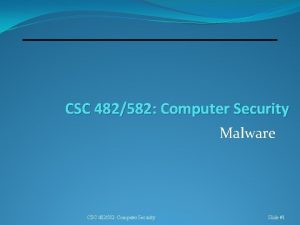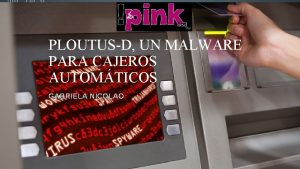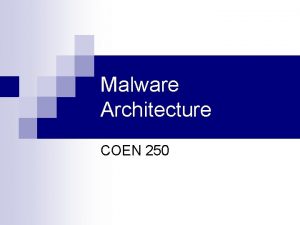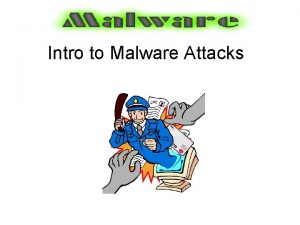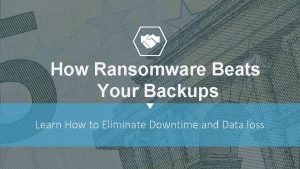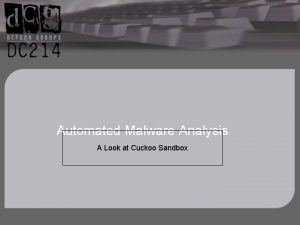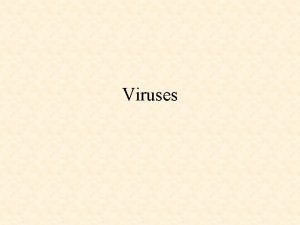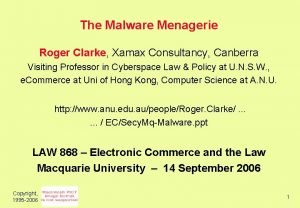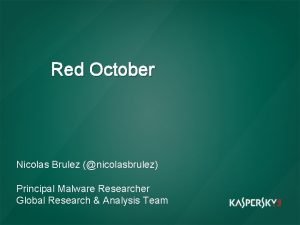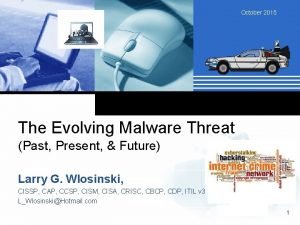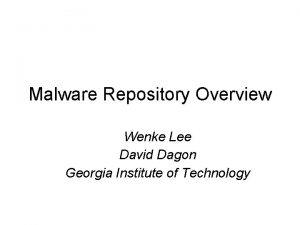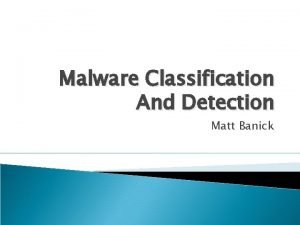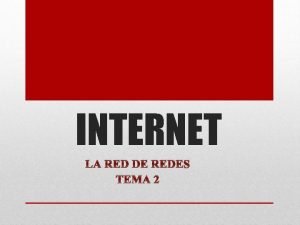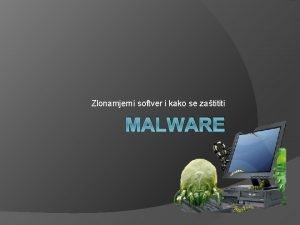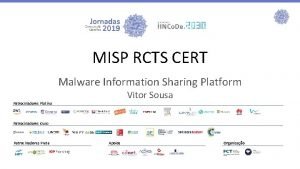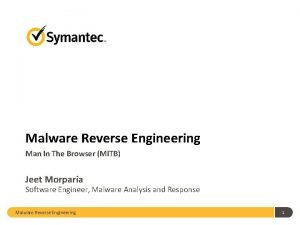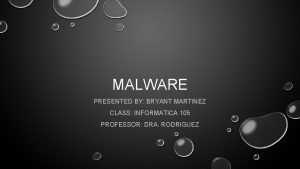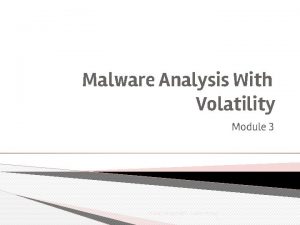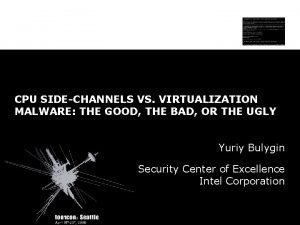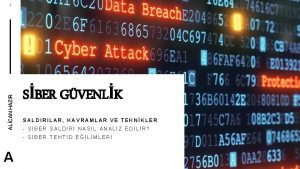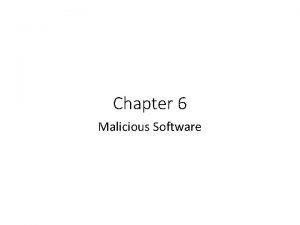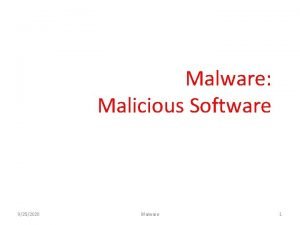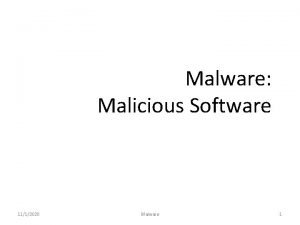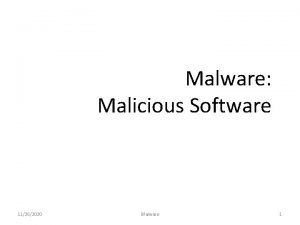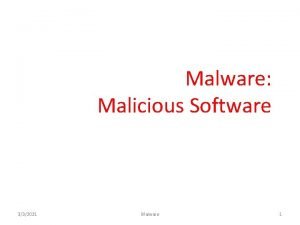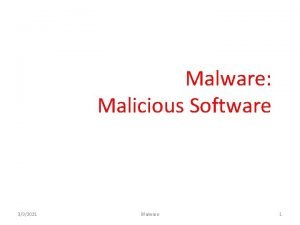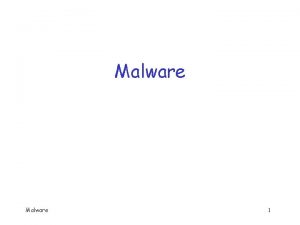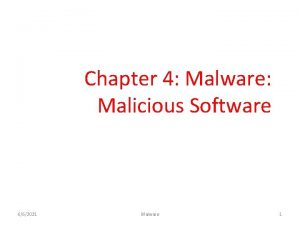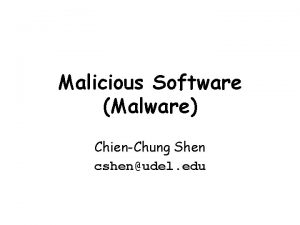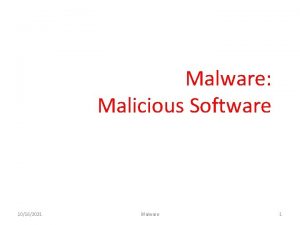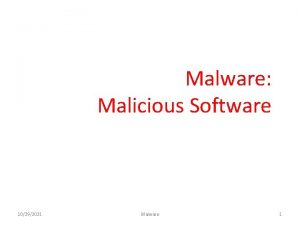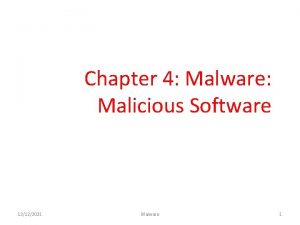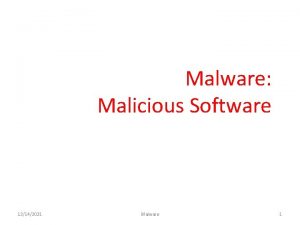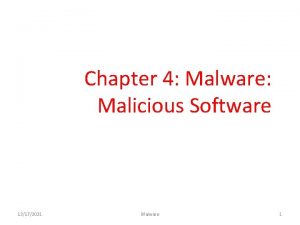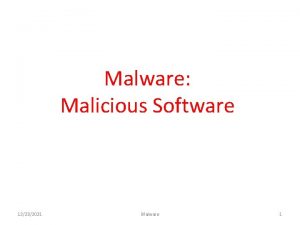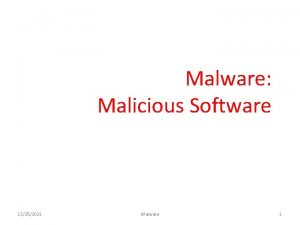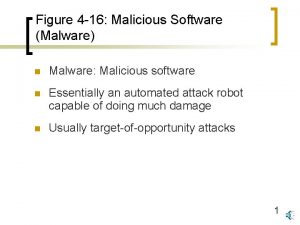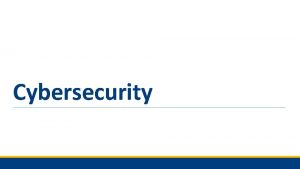Malicious Software Malware short for malicious software SOUP

![Malware, short for "malicious software" [SOUP 13] defines malware as: “a program that is Malware, short for "malicious software" [SOUP 13] defines malware as: “a program that is](https://slidetodoc.com/presentation_image_h2/7f639ff3c4291e825e424f4cd8396128/image-2.jpg)











































- Slides: 45

Malicious Software
![Malware short for malicious software SOUP 13 defines malware as a program that is Malware, short for "malicious software" [SOUP 13] defines malware as: “a program that is](https://slidetodoc.com/presentation_image_h2/7f639ff3c4291e825e424f4cd8396128/image-2.jpg)
Malware, short for "malicious software" [SOUP 13] defines malware as: “a program that is inserted into a system, usually covertly (secretly), with the intent of compromising the Confidentiality, Integrity, or Availability of the victim’s data, applications, or operating system or otherwise annoying or disrupting the victim. ”

Table 6. 1 Malware Terminology (Table can be found on page 201 in the textbook. )

Classification of Malware Classified into two broad categories: Also classified by: Based first on how it spreads or propagates to reach the desired targets Those that need a host program (parasitic code such as viruses) Then on the actions or payloads it performs once a target is reached Those that are independent, self-contained programs (worms, trojans, and bots) Malware that does not replicate (Trojans and spam e-mail) Malware that does replicate (viruses and worms)

Types of Malicious Software (Malware) • Propagation Mechanisms include: • Infection of existing content by viruses that is subsequently spread to other systems • Exploit of software vulnerabilities by worms or drive-by-downloads to allow the malware to replicate • Social engineering attacks that convince users to bypass security mechanisms to install Trojans or to respond to phishing attacks • Payload actions performed by malware once it reaches a target system can include: • Corruption of system or data files • Theft of service/make the system a zombie agent of attack as part of a botnet • Theft of information from the system/keylogging • Stealthing /hiding its presence on the system

Attack Kits • Initially the development and deployment of malware required considerable technical skill by software authors o The development of virus-creation toolkits in the early 1990 s and then more general attack kits in the 2000 s greatly assisted in the development and deployment of malware • Toolkits are often known as “crimeware” o Include a variety of propagation mechanisms and payload modules that even novices can deploy o Variants that can be generated by attackers using these toolkits creates a significant problem for those defending systems against them • Widely used toolkits include: o Zeus o Blackhole o Sakura o Phoenix

Attack Sources • Another significant malware development is the change from attackers being individuals often motivated to demonstrate their technical competence to their peers to more organized and dangerous attack sources such as: Politically motivated attackers Criminals Organized crime Organizations that sell their services to companies and nations National government agencies • This has significantly changed the resources available and motivation behind the rise of malware and has led to development of a large underground economy involving the sale of attack kits, access to compromised hosts, and to stolen information

Viruses • Piece of software that infects programs o Modifies them to include a copy of the virus o Replicates and goes on to infect other content o Easily spread through network environments • When attached to an executable program, a virus can do anything that the program is permitted to do o Executes secretly when the host program is run • Specific to operating system and hardware o Takes advantage of their details and weaknesses

Virus Components Infection mechanism • Means by which a virus spreads or propagates • Also referred to as the infection vector Trigger • Event or condition that determines when the payload is activated or delivered • Sometimes known as a logic bomb Payload • What the virus does (besides spreading) • May involve damage (malicious) or benign but noticeable activity

Virus Phases 1. Dormant/asleep phase Virus is idle Will eventually be activated by some event Not all viruses have this stage 2. Triggering phase Virus is activated to perform the function for which it was intended Can be caused by a variety of system events 3. Propagation phase Virus places a copy of itself into other programs or into certain system areas on the disk May not be identical to the propagating version Each infected program will now contain a clone of the virus which will itself enter a propagation phase 4. Execution phase Function is performed May be harmless or damaging

Virus Structure


Virus Classification by Concealment/Hiding Strategy Classification by target • Boot sector infector o Infects a master boot record (MBR) or boot record and spreads when a system is booted from the disk containing the virus • File infector • o A portion of the virus creates a random encryption key and encrypts the remainder of the virus • Macro virus o Infects files with macro or scripting code that is interpreted by an application • Multipartite virus o Infects files in multiple ways Stealth virus (sneaking) o A form of virus explicitly designed to hide itself from detection by anti-virus software o Infects files that the operating system or shell considers to be executable • Encrypted virus • Polymorphic virus o A virus that mutates with every infection • Metamorphic virus o A virus that mutates and rewrites itself completely at each iteration and may change behavior as well as appearance

Macro and Scripting Viruses • NISTIR 7298 defines a macro virus as: “a virus that attaches itself to documents and uses the macro programming capabilities of the document’s application to execute and propagate” • Macro viruses infect scripting code used to support active content in a variety of user document types • Are threatening for a number of reasons: • • Is platform independent • Are much easier to write or to modify than traditional executable viruses Infect documents, not executable portions of code (MS Word, PDF, etc. ) Are easily spread Because they infect user documents rather than system programs, traditional file system access controls are of limited use in preventing their spread, since users are expected to modify them

Worms • Program that actively seeks out more machines to infect o Each infected machine serves as an automated launching pad for attacks on other machines • Exploits software vulnerabilities in client or server programs • Can : o Spread through Network Connections from system to system o Spread through Shared Media (USB drives, CD, DVD data disks) o Spread through E-mails, email worms spread in macro or script code included in attachments and instant messenger file transfers • Upon activation the worm may replicate and propagate again • Usually carries some form of payload/action • First known worm implementation o was done in Xerox Palo Alto Labs in the early 1980 s o It was not malicious , searching for idle systems to use to run a computationally intensive task

Worm Replication E-mail or instant messenger facility File sharing Remote execution capability Remote file access or transfer capability Remote login capability • Worm e-mails a copy of itself to other systems • Often, sends itself as an attachment via an instant message service • Creates a copy of itself or infects a file as a virus on removable media (auto run mechanism ) • Worm executes a copy of itself on another system • Worm uses a remote file access or transfer service to copy itself from one system to another • Worm logs onto a remote system as a user and then uses commands to copy itself from one system to the other

Worm Replication • A worm typically uses the same phases as a computer virus: o dormant, propagation, triggering, and execution. • The propagation phase generally performs the following functions: o Search for appropriate access mechanisms to other systems to infect by examining host tables, address books, buddy lists, trusted peers, • scanning possible target host addresses; or by searching for suitable removable media devices to use. o Use the access mechanisms found to transfer a copy of itself to the remote system, and cause the copy to be run. o The worm may also attempt to determine whether a system has previously been infected before copying itself to the system.

• Target Discovery Scanning (or fingerprinting) o Propagation phase for a network, worm searches for other systems to infect Scanning strategies that a worm can use: • Random • Each compromised host probes random addresses in the IP address space using a different seed • This produces a high volume of Internet traffic which may cause generalized disruption even before the actual attack is launched • Hit-list • • The attacker first compiles a long list of potential vulnerable machines Once the list is compiled the attacker begins infecting machines on the list Each infected machine is provided with a portion of the list to scan This results in a very short scanning period which may make it difficult to detect that infection is taking place • Topological • This method uses information contained on an infected victim machine to find more hosts • Local subnet • If a host can be infected behind a firewall, then it looks for targets in its own local network • The host uses the subnet address structure to find other hosts that would otherwise be protected by the firewall

Morris Worm • One of the Earliest significant worm infection • Released by Robert Morris in 1988 • Designed to spread on UNIX systems o Attempted to crack local password file to use login/password to logon to other systems o Exploited a bug in the finger protocol which reports the whereabouts/ location of a remote user o Exploited a trapdoor in the debug option of the remote process that receives and sends mail • Successful attacks achieved communication with the operating system command interpreter o Sent interpreter a bootstrap program to copy worm over

Recent Worm Attacks Melissa 1998 e-mail worm, first to include Virus+ Worm + Trojan in one package Code Red July 2001 exploited Microsoft IIS bug Probes/examines random IP addresses consumes significant Internet capacity when active Code Red II August 2001 also targeted Microsoft IIS installs a backdoor for access Nimda September 2001 had Worm, Virus and Mobile code characteristics spread using e-mail, Windows shares, Web servers, Web clients, backdoors SQL Slammer Early 2003 exploited a buffer overflow vulnerability in SQL server compact and spread rapidly Sobig. F Late 2003 exploited open proxy servers to turn infected machines into spam engines Mydoom 2004 mass-mailing e-mail worm installed a backdoor in infected machines Warezov 2006 creates executables in system directories sends itself as an e-mail attachment can disable security related products Conficker (Downadup) November 2008 exploits a Windows buffer overflow vulnerability most widespread infection since SQL Slammer Stuxnet 2010 restricted rate of spread to reduce chance of detection targeted industrial control systems Mc. Afee: What Is Stuxnet? https: //www. mcafee. com/enterprise/en-us/security-awareness/ransomware/what-is-stuxnet. html

Multiplatform Metamorphic Worm Technology Polymorphic Multi-exploit Ultrafast spreading

Newer Worms technology • Multiplatform: not limited to Windows: UNIX; macro, scripting etc. • Multi-exploit: penetrate systems in a variety of ways: o E. g. servers, browsers, e-mail, file sharing, shared media, etc. • Ultrafast Spreading: maximize locating as many vulnerable machines as possible in a short time period. • Polymorphic: To evade detection, worms adopt the virus polymorphic technique. o New code generated on the fly using functionally equivalent instructions & encryption techniques. • Metamorphic: Changing their appearance and it behavioral patterns. o have a collection of behavior patterns that are unleashed at different stages of propagation • Transport vehicles: Can rapidly compromise a large number of systems, o they are ideal distributed Do. S bots, rootkits, spam e-mail generators, and spyware. • Zero-day exploit : maximum surprise and distribution, o exploit an unknown vulnerability that is only discovered by the general network community when the worm is launched.

Malicious Mobile Code • Programs that can be shipped unchanged to a variety of platforms o (e. g. , script, macro, or other portable instruction) • Transmitted from a remote system to a local system and then executed on the local system • Often acts as a mechanism for a Virus, Worm, or Trojan horse • Takes advantage of vulnerabilities to perform its own exploits • Popular vehicles include: o Java applets, o Active. X, o Java. Script and o VBScript

Mobile Phone Worms • First discovery was Cabir worm in 2004 • Then Lasco and Comm. Warrior in 2005 • Communicate through Bluetooth wireless connections or MMS • Target is the smartphone • Can completely: o disable the phone, o delete data on the phone, or o force the device to send costly messages • Comm. Warrior replicates by means of Bluetooth to other phones, o sends itself as an MMS file to contacts and o as an auto reply to incoming text messages

Drive-By-Downloads • Exploits browser vulnerabilities to download and installs malware on the system when the user views a Web page that is controlled by the attacker o It contains code that exploits the browser bug to download and install malware on the system without the user’s knowledge or consent. • In most cases does not actively propagate • Spreads when users visit the malicious Web page A drive-by download refers to the unintentional download of malicious code to your computer or mobile device that leaves you open to a cyberattack. (press a link, or open a malicious email attachment to become infected. ) Kaspersky: What Is a Drive-By Download? https: //www. kaspersky. com/resource-center/definitions/drive-by-download

Clickjacking • Also known as a user-interface (UI) redress/reform attack • Using a similar technique, keystrokes can also be hijacked • o A user can be led to believe they are typing in the password to their email or bank account, but are instead typing into an invisible frame controlled by the attacker E. g. you may think you're viewing the bank's display after entering your ID and password, but what you actually see is a replica of the same screen laid on top of the bank's real information. Vulnerability used by an attacker to collect an infected user’s clicks o The attacker can force the user to do a variety of things from adjusting the user’s computer setters to unwittingly sending the user to Web sites that might have malicious code o By taking advantage of Adobe Flash or Java. Script an attacker could even place a button under or over a legitimate button making it difficult for users to detect o A typical attack uses multiple transparent or opaque layers to trick a user into clicking on a button or link on another page when they were intending to click on the top level page o The attacker is hijacking clicks meant for one page and routing them to another page Kaspersky: What Is Clickjacking? https: //www. kaspersky. com/resource-center/definitions/clickjacking

Social Engineering • “Tricking” users to assist in the compromise of their own systems or personal information. • This can occur when a user views and responds to some SPAM e-mail, or permits the installation and execution of some Trojan horse program or scripting code. Spam (uninvited) Unsolicited bulk e-mail Trojan horse (apparently useful) Mobile phone Trojans Program or utility containing harmful hidden code First appeared in 2004 (Skuller) Used to accomplish functions that the attacker could not accomplish directly Target is the smartphone Significant carrier of malware Used for phishing attacks

Payload System Corruption Chernobyl Virus Klez • First seen in 1998 • Windows 95 and 98 virus • Infects executable files and corrupts the entire file system when a trigger date is reached • Mass mailing worm infecting Windows 95 to XP systems • On trigger date causes files on the hard drive to become empty Ransomware • Encrypts the user’s data and demands payment in order to access the key needed to recover the information • PC Cyborg Trojan (1989) • Gpcode Trojan (2006) • Wanna. Cry (May 2017) https: //www. kaspersky. com/resource-center/threats/hardware-failure https: //www. kaspersky. com/about/press-releases/2002_free-defense-against-the-internet-worm-klez https: //www. us-cert. gov/Ransomware https: //www. trendmicro. com/vinfo/us/security/news/ransomware

k W a re a w m o. org s an dia r y ipe r a. C wik n n a c tta

Payload System Corruption • Real-world damage • Causes damage to physical equipment o Chernobyl virus rewrites BIOS code o Stuxnet worm • Targets specific industrial control system software • There are concerns about using sophisticated targeted malware for industrial sabotage • Logic bomb • Code embedded in the malware that is set to “explode” when certain conditions are met

Payload – Attack Agents Bots • Takes over another Internet attached computer and uses that computer to launch or manage attacks • Botnet - collection of bots capable of acting in a coordinated manner (A botnet is a number of Internet-connected devices (bots), each of which is running one or more bots. ) • Can be used to cause/make: • Distributed denial-of-service (DDo. S) • Spamming • Sniffing traffic • Keylogging • Spreading new malware • Installing advertisement add-ons and browser helper objects (BHOs) • Attacking IRC chat networks • Manipulating online Polls/Games (i. e. elections !? )

1. The botmaster sends out malware to infect computers. 2. Once in your system, the malware will use the internet to make contact with the command & control server (C 2). 3. Once the botmaster has a purpose for the botnet, he/she sends instructions to the bots via the command & control server. 4. the botmaster will be focussed on recruiting more and more computers to expand the botnet.

Remote Control Facility • Distinguishes a bot from a worm • Worm propagates itself and activates itself • Bot is initially controlled from some central facility (master) • Typical means of implementing the remote control facility is on an IRC server (Internet Relay Chat, an old and obsolete application layer chat protocol) • Bots join a specific channel on this server and treat incoming messages as commands • More recent botnets use covert communication channels via protocols such as HTTP • Distributed control mechanisms use peer-to-peer protocols to avoid a single point of failure

Payload – Information Theft Keyloggers and Spyware Keylogger • Captures keystrokes to allow attacker to monitor sensitive information • Typically uses some form of filtering mechanism that only returns information close to keywords (“login”, “password”) Spyware • Subverts the compromised machine to allow monitoring of a wide range of activity on the system • Monitoring history and content of browsing activity • Redirecting certain Web page requests to fake sites • Dynamically modifying data exchanged between the browser and certain Web sites of interest

Payload – Information Theft Phishing • Exploits social engineering to leverage the user’s trust by masquerading as communication from a trusted source o Include a URL in a spam e-mail that links to a fake Web site that mimics the login page of a banking, gaming, or similar site o Suggests that urgent action is required by the user to authenticate their account o Attacker exploits the account using the captured credentials • Spear-phishing o Recipients are carefully researched by the attacker o E-mail is crafted to specifically suit its recipient, o often quoting a range of information to convince them of its authenticity

Worm Countermeasures • Considerable overlap in techniques for dealing with viruses and worms o Once a worm is resident on a machine anti-virus software can be used to detect and possibly remove it o Perimeter network activity and usage monitoring can form the basis of a worm defense • Worm defense approaches include: o A. Signature-based worm scan filtering (prevent worm scans from entering/leaving network/host) • a signature is an algorithm or hash (a number derived from a string of text) that uniquely identifies a specific virus/worm. o B. Filter-based worm containment (content rather than a scan signature. ) o C. Payload-classification-based worm containment (examine network packets) o D. Threshold random walk (TRW) scan detection (effective against common worm behaviors) o E. Rate limiting (i. e. limiting the number of new machines a host can connect to in a window of time) o F. Rate halting (blocks outgoing traffic when a threshold is exceeded either in outgoing connection rate )

Payload – Stealthing Backdoor • Also known as a trapdoor • Secret entry point into a program allowing the attacker to gain access and bypass the security access procedures • Maintenance hook is a backdoor used by Programmers to debug and test programs • Difficult to implement operating system controls for backdoors in applications E. g. New Stealth Falcon Backdoor Discovered (September 10, 2019) https: //www. securityweek. com/new-stealth-falcon-backdoor-discovered

Payload – Stealthing Rootkit • A rootkit is a set of hidden programs installed on a system to maintain covert/hidden access to that system with administrator (or root) privileges o The rootkit alters the host’s standard functionality in a malicious and stealthy way • Hides by subverting/corrupting the mechanisms that monitor and report on the processes, files, and registries on a computer • Gives administrator (or root) privileges to attacker • Can add or change programs and files, monitor processes, send and receive network traffic, and get backdoor access on demand E. g. Rootkit -- An Intruder Living in your Kernel https: //www. symantec. com/connect/articles/rootkit-intruder-living-your-kernel

Rootkit Classification Characteristics Persistent Memory based User mode Kernel mode Virtual machine based External mode

Malware Countermeasure Approaches • Ideal solution to the threat of malware is prevention Four main elements of prevention: • Policy • Awareness • Vulnerability mitigation • Threat mitigation • If prevention fails, technical mechanisms can be used to support the following threat mitigation options: • • • Detection Identification Removal

Generations of Anti-Virus Software First generation: simple scanners • Requires a malware signature to identify the malware • Limited to the detection of known malware Second generation: heuristic scanners • Uses heuristic rules to search for probable malware instances • i. e. fragments of code that are often associated with a malware • Another approach is integrity checking Third generation: activity traps • Memory-resident programs that identify malware by its actions rather than its structure in an infected program Fourth generation: full-featured protection • Packages consisting of a variety of anti-virus techniques used in conjunction (all of the above) • Include scanning and activity trap components and access control capability

Generic Decryption (GD) • Enables the anti-virus program to easily detect complex polymorphic viruses and other malware while maintaining fast scanning speeds • Executable files are run through a GD scanner which contains the following elements: • CPU emulator • Virus signature scanner • Emulation control module • The most difficult design issue with a GD scanner is to determine how long to run each interpretation

Host-Based Behavior-Blocking Software • Integrates with the operating system of a host computer and monitors program behavior in real time for malicious action • Blocks potentially malicious actions before they have a chance to affect the system • Blocks software in real time so it has an advantage over anti-virus detection techniques such as fingerprinting or heuristics Limitations • Because malicious code must run on the target machine before all its behaviors can be identified, it can cause harm before it has been detected and blocked

Perimeter Scanning Approaches • • Anti-virus software typically included in e-mail and Web proxy services running on an organization’s firewall and IDS Ingress monitors May also be included in the traffic analysis component of an IDS • May include intrusion prevention measures, blocking the flow of any suspicious traffic • Approach is limited to scanning malware Located at the border between the enterprise network and the Internet One technique is to look for incoming traffic to unused local IP addresses Egress monitors Located at the egress point of individual LANs as well as at the border between the enterprise network and the Internet Monitors outgoing traffic for signs of scanning or other suspicious behavior Two types of monitoring software

Summary • Types of malicious software (malware) • Advanced persistent threat • Propagation o Infected content • viruses o Vulnerability exploit • worms o Social engineering • spam • e-mail • Trojans • Payload o System corruption o Attack agent • Zombie • Bots o Information theft • Keyloggers • Phishing • Spyware o Stealthing • Countermeasures
 Short short short long long long short short short
Short short short long long long short short short Cuckoo sandbox
Cuckoo sandbox Short for malicious software
Short for malicious software Malicious software in cryptography
Malicious software in cryptography Malicious software
Malicious software Mbrojtja nga viruset kompjuterike
Mbrojtja nga viruset kompjuterike Rhmd: evasion-resilient hardware malware detectors
Rhmd: evasion-resilient hardware malware detectors Malware radar
Malware radar Ddos tabletop exercise
Ddos tabletop exercise Symbian malware
Symbian malware Memory forensics training
Memory forensics training Misp malware
Misp malware Wat is malware
Wat is malware Pihole adlists
Pihole adlists Malware, nella sicurezza informatica indica
Malware, nella sicurezza informatica indica Malware reverse engineering training
Malware reverse engineering training Oligomorphism
Oligomorphism Malware analysis
Malware analysis Unlabel
Unlabel Type de malware
Type de malware Dynamic analysis malware
Dynamic analysis malware Ploutus atm malware
Ploutus atm malware Malware programy
Malware programy Malware architecture
Malware architecture Intro to malware
Intro to malware Malware beats
Malware beats Cuckoo sandbox online
Cuckoo sandbox online Malware versus virus
Malware versus virus Roger malware
Roger malware Malware researcher
Malware researcher Dyre malware wiki
Dyre malware wiki Malfeases
Malfeases Malware taxonomy
Malware taxonomy Tipos de malware
Tipos de malware Zlonamjerni softver
Zlonamjerni softver Malware information sharing platform
Malware information sharing platform Man in the browser malware
Man in the browser malware Malware informatica
Malware informatica Volatility kali linux
Volatility kali linux Second life malware
Second life malware Virtualization malware
Virtualization malware Malware çeşitleri
Malware çeşitleri Kontinuitetshantering
Kontinuitetshantering Typiska novell drag
Typiska novell drag Nationell inriktning för artificiell intelligens
Nationell inriktning för artificiell intelligens Vad står k.r.å.k.a.n för
Vad står k.r.å.k.a.n för


